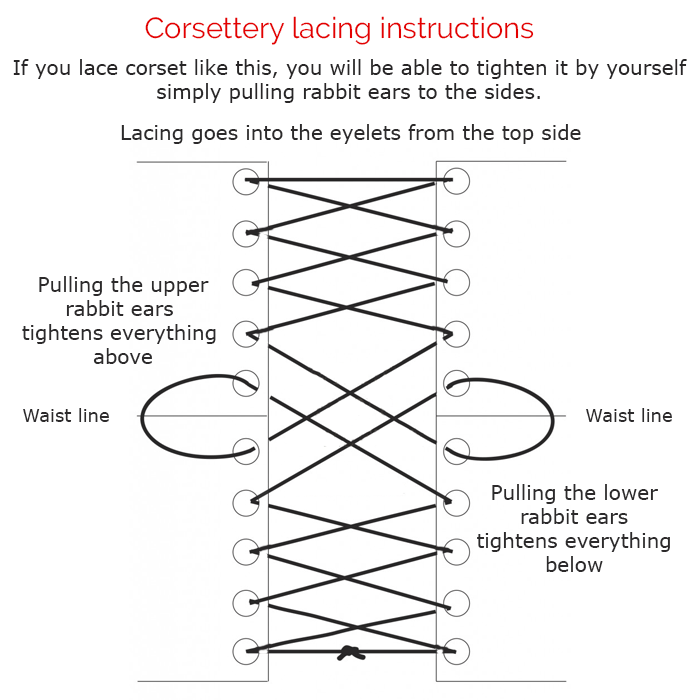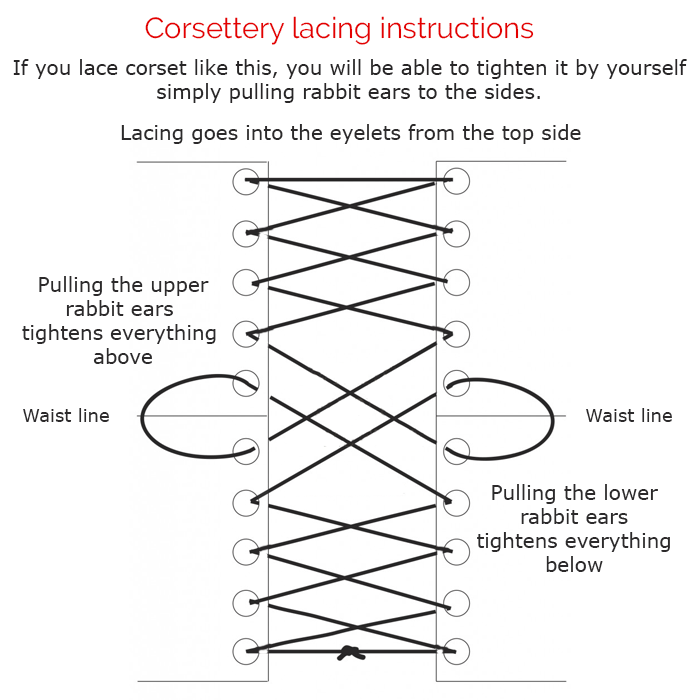Buy your weekday smoothies and get your weekend ones for free. (7 for the price of 5!)

Es gibt viele Möglichkeiten, wie Sie Ihr neues Korsett schnüren können. German Wir werden Ihnen einige davon anbieten und Vor- und Nachteile jedes einzelnen erklären. Unser Leitfaden wird auch kompletten Anfängern helfen, und es wird nur einige Zeit dauern, bis Sie entscheiden, wie Sie Ihr Korsettband schnüren möchten. Es gibt eine Methode, die bequemer ist, um das Korsett selbst zu straffen, oder Methoden, die geeignet sind, wenn Sie um Hilfe bitten können.
Kaufen Sie hier die Korsett-Schnürsenkel.
German ```Es wird ein spezielles hartes Korsettband mit jedem unserer Korsetts mitgeliefert. Aber Sie können ein anderes Band kaufen, wenn Sie ein Satinband in derselben Farbe wie Ihr Korsett haben möchten. Denken Sie daran, dass dünne Satinbänder, die in jedem Stoffgeschäft verkauft werden, nur einmal oder zweimal zum Festziehen Ihres Korsetts verwendet werden können und geeignet sind, wenn Sie es gelegentlich oder bei einer Hochzeit tragen. Unser Schnürkorsettband ist viel fester und wurde speziell entwickelt, um das Korsett wirklich festzuziehen.authentisches KorsettBitte denken Sie daran, dass Sie nur ein langes Stück Band zum Schnüren des Korsetts benötigen, schneiden Sie es nicht in zwei Stücke.
Kaufe Schnürsenkel für dein authentisches Korsett.
Ways to lace your corset ``` ``` Wege, um Ihr Korsett zu schnüren
Der erste Weg zum Schnüren, der für Personen geeignet ist, die ihr Korsett selbst enger schnüren möchten.

- Stellen Sie Ihr Korsett vor sich auf den Tisch. Der obere Teil (wo sich die Etiketten befinden) oben und der untere Teil (wo einige Korsetts spezielle Schlaufen für Strumpfhalter haben können) unten.
- Finde die Mitte deines Schnürsenkels.
- beginnen Sie, das Korsett von oben zu schnüren, lassen Sie etwa 2-3 Zoll zwischen den beiden Teilen des Korsetts und lassen Sie die Mitte des Schnürsenkels zwischen den oberen Löchern.
- beginnen Sie mit dem Schnüren nach unten, wechseln Sie die Seiten und Löcher ab, bis Sie die Taille erreichen (normalerweise hat sie ein Taillenband auf der Innenseite).
- Nach diesem Schritt erstellen Sie eine große Schleife, indem Sie das Band herausführen und dann auf derselben Seite wieder hineinführen. Sie werden wahrscheinlich mit ein paar Fuß Band auf jeder Seite enden. Fahren Sie mit dem Einfädeln fort, bis Sie den Boden des Korsetts erreichen.
- Am Ende gibt es zwei Optionen, zwischen denen Sie wählen können - die beiden Enden des Kabels zusammenzubinden oder an jedem Ende zwei Knoten zu machen.
- Wenn Sie anfangen, das Korsett anzuziehen, ziehen Sie die Schlaufen mit beiden Händen zu den Seiten, um das Korsett zu straffen. Binden Sie dann eine Schleife, wenn Sie mit dem Festziehen fertig sind.
Auf diese Weise wird das Schnürsenkelmuster aufechtes KorsettGerman .
Vollständige Sammlung von engen Korsetts mit schwerer Schnürung
Die zweite Art des Schnürens ist komplizierter, um von Ihnen selbst festgezogen zu werden, und wird empfohlen, wenn Sie jemanden haben, der Ihnen hilft, aber es wird schön und hübsch aussehen.

Das Ergebnis wird so aussehen
Anzeigenvollständige Sammlung von authentischen Korsetts
Schauen Sie sich auch unsereHochzeitskorsagenAnleitung.
Wenn Sie lernen möchten, wie Sie ein Korsett alleine schnüren und binden können, sind Sie hier genau richtig! Korsetts sind eine großartige Möglichkeit, jedem Outfit eine besondere Note zu verleihen, und das Erlernen des Schnürens und Bindens selbst ist eine großartige Möglichkeit, Geld zu sparen und sicherzustellen, dass Ihr Korsett perfekt passt.
Before you start lacing your corset, you’ll need to pick the right size for you. Your corset should fit snugly against your body, but it should not be so tight that it is uncomfortable or causes any pain. Once you’ve got the right size, it’s time to start lacing!
To lace your corset, start by threading the laces through the grommets (small holes or eyelets) on the back of the corset. Make sure that you thread the laces in the same direction on both sides. Once you have the laces threaded through the grommets, begin to tie them together in a knot at the top.
Sobald du den Knoten gebunden hast, fange an, die Schnürsenkel festzuziehen. Du solltest dies allmählich tun und darauf achten, die Schnürsenkel gleichmäßig auf beiden Seiten zu ziehen. Wenn du die Schnürsenkel ziehst, wirst du sehen, wie das Korsett Form annimmt. Wenn du die Schnürsenkel so fest wie möglich gezogen hast, binde sie unten zu einer Schleife zusammen.
Now that your corset is laced, it’s time to tie it up. Start by wrapping the laces around your waist, making sure to keep the laces even on both sides. Once you’ve wrapped the laces around your waist, tie them in a bow at the top.```
```Jetzt, da dein Korsett geschnürt ist, ist es Zeit, es zu binden. Beginne damit, die Schnürsenkel um deine Taille zu wickeln und achte darauf, dass die Schnürsenkel auf beiden Seiten gleichmäßig sind. Sobald du die Schnürsenkel um deine Taille gewickelt hast, binde sie oben zu einer Schleife.
Schließlich müssen Sie die Schnürsenkel anpassen, um die perfekte Passform zu erhalten. Lockern Sie zunächst die Schnürsenkel oben und ziehen Sie sie dann allmählich fest, bis das Korsett eng an Ihrem Körper anliegt. Wenn Sie die perfekte Passform gefunden haben, binden Sie die Schnürsenkel unten zu einer Schleife.
Und da haben Sie es! Jetzt wissen Sie, wie Sie ein Korsett alleine schnüren und binden können. Mit ein wenig Übung werden Sie in der Lage sein, das perfekte Korsett für jedes Outfit zu kreieren.

















As someone who wears corsets both for fashion styling and waist support, I absolutely loved this post. I wear overbust corsets when dressing up for events, but I also wear a cotton underbust corset daily under my outfits for posture and waist training. I had no idea that using the wrong lacing method could actually reduce the effectiveness of a corset or damage it over time.
This post helped me switch to a proper lacing method that not only looks neater but also preserves the shape of my corset longer. Especially for tight-lacing, even tension and secure loops are everything. It’s amazing how much better my corsets fit now, just because I learned the right way to lace them. Corsettery’s commitment to education makes them stand out so much in the corset community.
I wish I had seen this when I first started with corsets! I completely messed up my first satin corset by lacing it too tight at the top and not tightening from the waistline. I thought the discomfort was normal — turns out, I just didn’t know how to lace a corset properly. This article explains everything in such a beginner-friendly way.
I tried the bunny ear method you recommended, and the difference is incredible. Now I can wear my underbust corset from Corsettery for hours without feeling like I’m being squished in all the wrong places. The visuals and breakdowns of each technique really helped me understand what’s best for different corset styles.
Thank you for making waist training less intimidating!
Corsettery never disappoints when it comes to educating their audience. This article helped me finally understand the subtle differences between straight lacing, spiral lacing, and inverted bunny ears. I always thought lacing was just aesthetic, but now I realize how critical it is to get the right lacing technique for comfort, safety, and proper waist training.
I own several Corsettery corsets — leather, velvet, and mesh — and each one responds slightly differently to lacing. This guide gave me the confidence to adjust each one appropriately depending on the material and how tight I want to lace for the day. Honestly, it’s this kind of support and information that keeps me loyal to Corsettery. It’s more than just buying a corset — it’s learning how to wear it the right way.
This is by far one of the best guides I’ve read about how to properly lace a corset! I’ve owned corsets before, but no one ever explained the importance of lacing technique the way this post does. I recently purchased a real steel-boned underbust corset from Corsettery for waist training, and this guide completely changed the way I wear it. After switching to the bunny ears lacing method, I noticed how much more evenly the pressure distributes — no more sore ribs or uneven compression.
I also appreciate the advice on loosening the corset properly before taking it off. That’s such an overlooked tip but crucial for protecting the integrity of the fabric and boning. This blog post isn’t just educational — it’s a must-read for anyone serious about tight-lacing or wearing corsets long-term.
I’ve been tight-lacing for several years, and one thing I always tell people is this: the lacing technique matters as much as the corset itself. This guide covers that so well. Whether you’re into gothic, burlesque, or daily waist training, proper lacing will protect your corset and your body. Corsettery is one of the few brands that makes real double-steel boned corsets that can handle actual training, and this guide proves they really know what they’re doing.